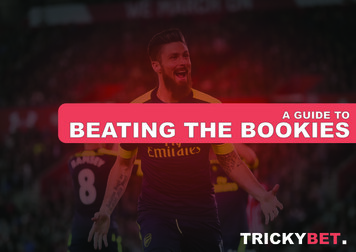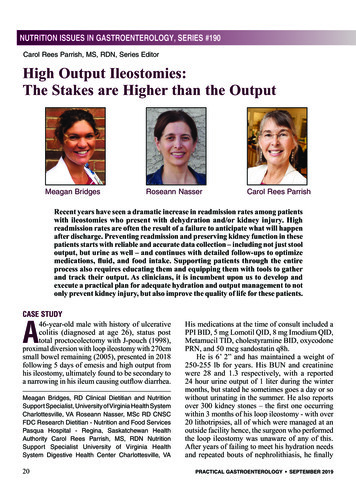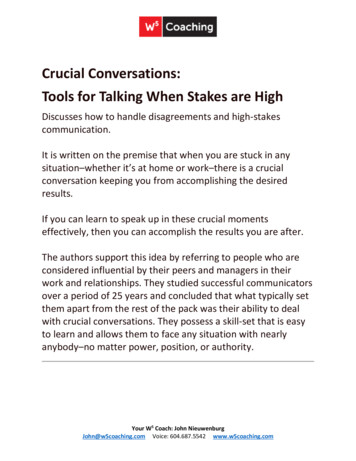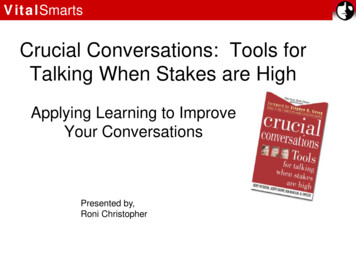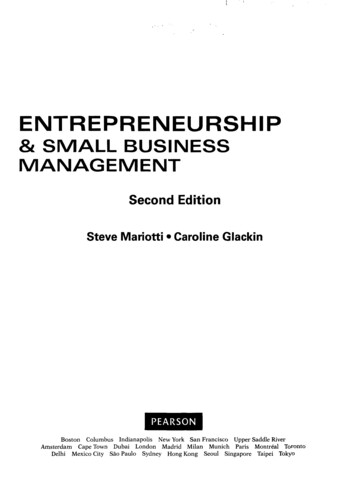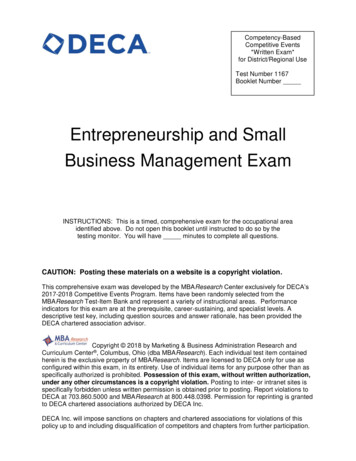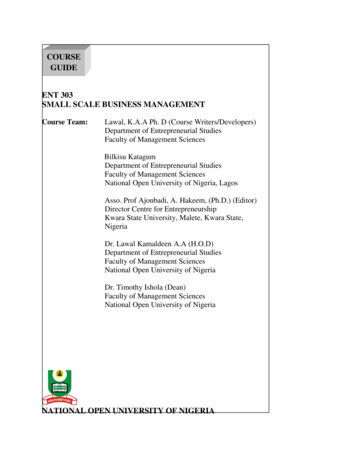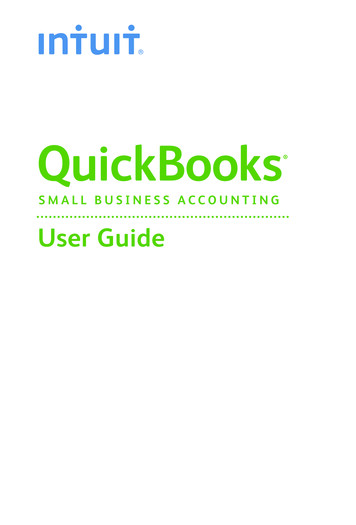
Transcription
Strategies for Beating Small Stakes Poker TournamentsBy Jonathan LittleEdited by Ken Adams
ContentsFree Bonus Video & PDFIntroductionFocus on your opponentsThe three player types who play small stakes tournamentsThose who play too many handsThose who play too many hands too passivelyThose who play too many hands too aggressivelyThose who play too few handsThose who play too few hands too passivelyThose who play too few hands too aggressivelyThose who play roughly the correct amount of hands in an intelligent mannerPay attention!Specific tendencies you will encounter in small stakes tournamentsConclusionResources
Free Bonus Video & PDFOne of the most impactful things you can do to immediately improve your tournamentstrategy is to learn how to increase your levels of aggression. However, it must bedone intelligently for it to be effective. The secret is to learn when to play aggressivelyand when to get out of the way.To get a free 11-minute video and 24-page PDF from me with tips on how to increaseyour levels of aggression, visit:FloatTheTurn.com/increasingaggression
IntroductionThere has been a lot written recently, particularly in eBook format, regarding how tobeat small stakes poker tournaments. Most books suggest that you either play anoverly tight strategy, hoping to trap your opponents who never fold, or an overly loosestrategy, hoping to steal lots of pots from your opponents who fold too often. Inreality, you should play a strategy that maximally exploits your specific opponents.I hate to be the bearer of bad news, but there is no silver bullet, as many of theseeBooks suggest. Guides that aim to teach you a default set of hands to play from eachposition are certain to fail you in the long run because each and every time you sit at apoker table, you play against a different set of opponents. For example, if you elect toplay an overly tight style, and you employ that strategy against players who will neverpay you off when you make a strong hand, you will blind out, guaranteeing failure. Ifyou instead play overly loose, against opponents who play in a manner that traps you,you will spew off your stack. You should not accept the idea that sometimes yourstrategy will simply fail when you get unlucky to be against the wrong type ofopponents.It is also worth mentioning that you should raise with a drastically different rangebased on your stack size. Hands such as 4-4 and 9 -7 are excellent when you have a
deep stack because of their potential to win a large number of chips if you flop well.However, if you have a 30 big blind stack, they become quite poor, especially fromearly position, because if you get lucky to flop well, you cannot win enough to justifylosing the amount you lose when you don’t connect with the flop or when you getreraised and have to fold before the flop.One of the best things you can do to improve your tournament skills is to learn how toincrease your levels aggression. That being said, aggression must be implementedintelligently to be effective. The key to using aggression effectively is knowing when toapply it and when to get out of the way.To get a free 11-minute video and 24-page PDF from me with tips on how to increaseyour levels of aggression, visit:FloatTheTurn.com/increasingaggressionThe secret to success in poker is to tailor your playing style to your specific opponents.Playing according to a simple hand chart doesn’t work because your opponents are notall playing the same way. Also, you will find that most of these books lay out an overlysimplistic strategy for playing after the flop. Again, this will fail miserably because itdoesn’t account for opponents’ tendencies.
As a simple example, suppose you raise with A -J to 2.5 big blinds out of your 75 bigblind stack from middle position and only the player in the big blind calls. The flopcomes J -7 -3 . Your opponent checks.Against almost all opponents, you should make a continuation bet of around 3 bigblinds, which is roughly 50% of the size of the pot. Let’s assume you make that bet andyour opponent calls.The turn is the (J -7 -3 )-Q . Your opponent checks. At this point, your play shouldvary widely based on your opponent’s tendencies. Against tight players who will foldalmost all hands worse than yours if you bet, you should check, forcing them to stay inthe pot with lots of hands that you crush. Against loose players who never fold anymade hand or draw to a turn bet, you should bet to get value from worse made handsand to protect your hand from various river cards that could give your opponent thehand. Let’s assume you are against a loose player and you decide to bet 50% of the potagain. Your opponent calls.The river is the (J -7 -3 -Q )-9 . Your opponent checks. Your play now depends onhow prone your opponent is to call on the river with his marginal hands. If he will calla river bet with an overly wide range of marginal made hands, such as J-8 and A-7, youshould make a thin value bet. It is important to bet an amount that is likely to getcalled by these junky made hands. In this situation, a bet of around 25% of the size ofthe pot should get called a large portion of the time. If your opponent will usually foldall hands worse than yours besides perhaps J-T and J-8, you should probably check
behind because if you get called, it is too likely that you no longer have the best hand.This simple example shows how mindlessly thinking “I have top pair, so I should bet”does not work. If you were to bet the turn and river in this scenario against a tightopponent, you are almost certainly burning money because he will only call you with abetter hand. If you fail to make a thin value bet against a calling station on the river,you are leaving money on the table. If you fail to alter your play based on youropponent’s tendencies, you will not win the maximum your winning hands and youwill lose more than you should with your losing hands. My goal is to teach you to crushyour opponents, not merely win a small amount from them by playing robotically.As with all of my poker training content, my goal is to teach you to think for yourself,so you will be able to select the best possible play in all situations you encounter forthe rest of your poker career. While I could certainly teach you to play a like a mindlessrobot, grinding out small amounts of money in the small stakes games, my goal is toteach you to be a big winner. I want to see you succeed and move up to the middleand high stakes games where you have the opportunity to win life-changing money.While there are no pre-flop hand charts in this book, which I am sure many of youhave come to expect from poker books in your quest to find one that actually works, Iprovide numerous examples that will give you a solid grasp of how I attack small stakestournaments. For a more in-depth analysis of my default poker strategies, I stronglysuggest you check out my best-selling tournament book series, Secrets of ProfessionalTournament Poker. You can get the audiobook version of Volume 1 for FREE simply by
clicking the link and following the instructions.Nothing makes me happier than to hear from my students who started off small andgrinded their way to the top, as I did many years ago when I deposited 50 ontoPartyPoker and rose through the ranks, eventually winning large sums of money andexperiencing success in all aspects of life. If I can do it, you can too. I aim to set you onthe right path so you do not waste countless hours listening to authors who lay out aflawed formula for you to blindly follow. While some of these simple strategies mayhave worked 15 years ago when many players were awful at poker, they will not worktoday because the average player is competent at the game.During the first few years of my poker career, I played using what was effectively anadvanced system. I eventually came to the realization that I was not winning at thehighest rate that I thought was possible. While following an intelligently crafted systemwill likely win you money, it will only win you a little. Playing like a robot in today’sgames does not produce significant results.You must realize that if you win at roughly 15% return on investment, which is aboutthe highest rate you can expect to win at by following a mindless strategy, you willbreak even or lose money after paying the rake. For example, if you normally play 65live tournaments, and 15 of the buy-in goes to the rake, which is fairly standard inmost casinos, a 15% return on your 50 investment means that you will win 7.50minus the 15 you paid to the rake, making you a 7.50 loser even though you arebetter than your opponents.
If instead, you achieve a 75% return on investment, which can only be accomplished bygetting well out of your comfort zone and blatantly exploiting your opponents’weaknesses, you will quickly progress from the small stakes games to the middle stakesgames, where you can start winning serious money. Notice by winning 37.50 pergame, even after paying 15 for rake, you profit 22.50 on average. While 22.50 pergame may not sound like a lot, if you play well and win that amount on average everytime you play, your bankroll will quickly grow.
Focus on your opponentsIn order to win large amounts, you must focus on your opponents. You have to keepyour eyes and ears open, actively observing their tendencies. If you only pay attentionto your own two cards, your position and your chip stack, you are certain to fail in thelong run. Fortunately for you, in the small stakes games, most of your opponents willbe oblivious to what you are doing, giving you free reign to do whatever you want.You must make a point to diligently pay attention the action during each and everyhand that takes place at the table. Paying attention only when you are involved in apot will not give you enough reliable information to get well out of line, which ismandatory if you are to maximize your equity. You have to be mindful while playingpoker. If you are mindlessly grinding, you are not playing optimally.I strongly suggest that you either take mental notes about everything you see youropponents doing, assuming your memory is good, or write notes in a notepad if yourmemory is bad. Because I recognize and accept that my memory is bad, I write downevery hand I play as well as a decent amount of the hands I witness at the poker table.While I occasionally get teased for actually taking the game seriously, I exploit myopponents better than almost anyone. That seems like a fine tradeoff to me!
When taking notes on your opponents, it is especially important to record what eachspecific player does incorrectly. For example, if you see someone on separate occasionsmaking very small and very large continuation bets on the flop, you should assumethat those bet sizes mean something. If you pay attention long enough, you will beable to see a few showdowns and figure out if a particular bet size correlates with ahand of a specific strength.Once you figure out what your specific opponent is doing incorrectly, you can takesteps to exploit his weakness, which is how you will produce a large profit in the longrun.For example, if you know your opponent continuation bets small on the flop withstrong hands and large with weak hands, you should fold all of your non-premiummade hands to small continuation bets. When facing a large continuation bet, youshould raise with your weak hands, forcing your opponent to fold, earning you the pot.With your strong hands, you should call because if you raise, your opponent will fold,making it impossible to extract additional value on the turn and river.Before moving forward, there is a concept you must grasp if you want to win at anyform of poker. If you do not understand this concept, you are certain to fail once youprogress beyond the small stakes. Pay attention, this is important!You must make a point to always think in terms of ranges, meaning you must acceptthat your opponents will play various hands in a similar manner. For example, if a
super-tight player raises from first position, you should not assume he has a specifichand, such as A-K. You should assume he has a range of hands, such as A-A, K-K, Q-Q, JJ and A-K. You can then narrow that range as the hand progresses based on youropponent’s actions. Obviously looser players will have much wider ranges on allbetting rounds, making them more difficult to play against. There will be morediscussion about ranges throughout this book simply because you cannot analyze apoker hand without assigning your opponent a range.When you have your opponent’s range crushed, such as when you have a straight andyou think the best hand your opponent can realistically have is one pair, you do NOTwant him to fold. You win at poker by making your opponent fold when you are beatand by getting value when you are decently far ahead.Suppose you raise to 250 out of your 5,000 stack at 50/100 with A -T from middleposition and only the big blind calls.The flop comes A -7 -2 . The pot is 550. Your opponent, who you know nothingabout, decides to bet into you for 400.This is a scenario where if you raise, your opponent will probably only call with a flushdraw or a strong made hand, unless he is a calling station who cannot fold any sort ofmarginal holding. We will assume that is not the case. This means that if you raise andget called, you are either against a draw that has roughly 40% equity (meaning you arenot too far ahead) or against what is likely a better made hand (meaning you are way
behind). Even though you “probably” have the best hand with your top pair, when youraise your opponent’s flop bet and he continues in the pot, you are usually in eithermarginal or bad shape. Of course, if your opponent decides to reraise, you are in evenworse shape.A much better play is to call, forcing your opponent to stay in the pot with a widerange of hands that you crush, including A -5 and 8 -7
have come to expect from poker books in your quest to find one that actually works, I provide numerous examples that will give you a solid grasp of how I attack small stakes tournaments. For a more in-depth analysis of my default poker strategies, I strongly suggest you check out my best-selling tournament book series, Secrets of Professional
